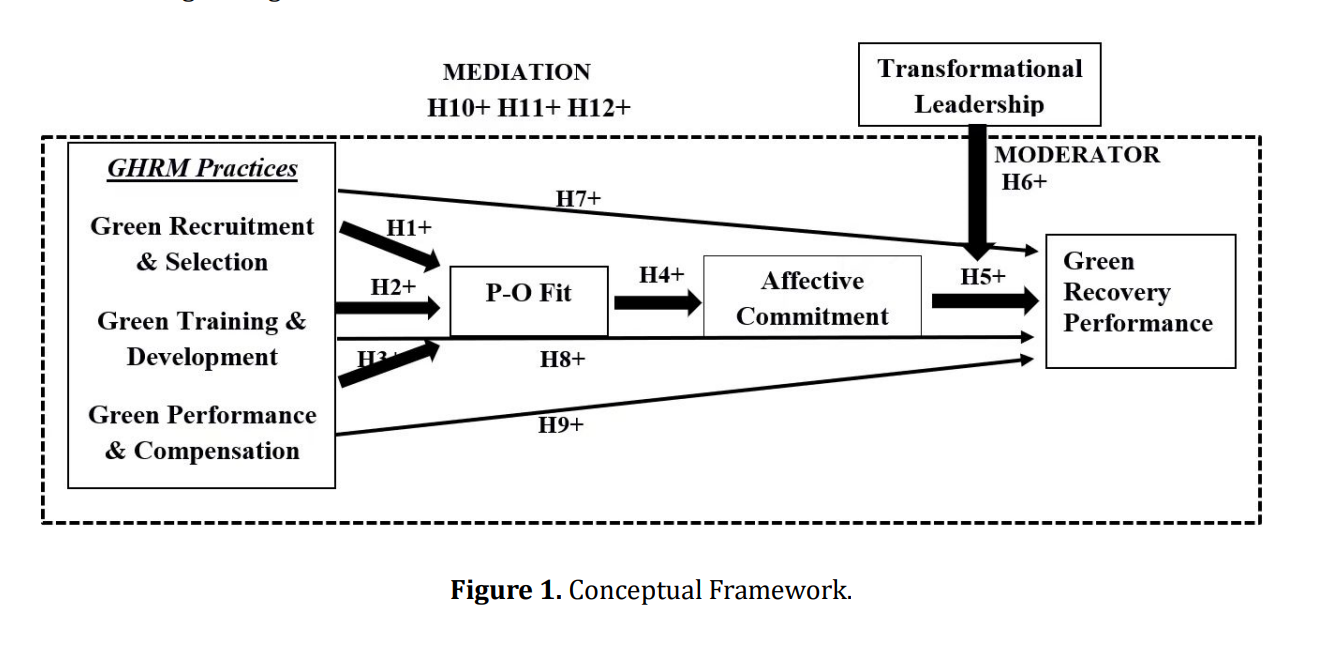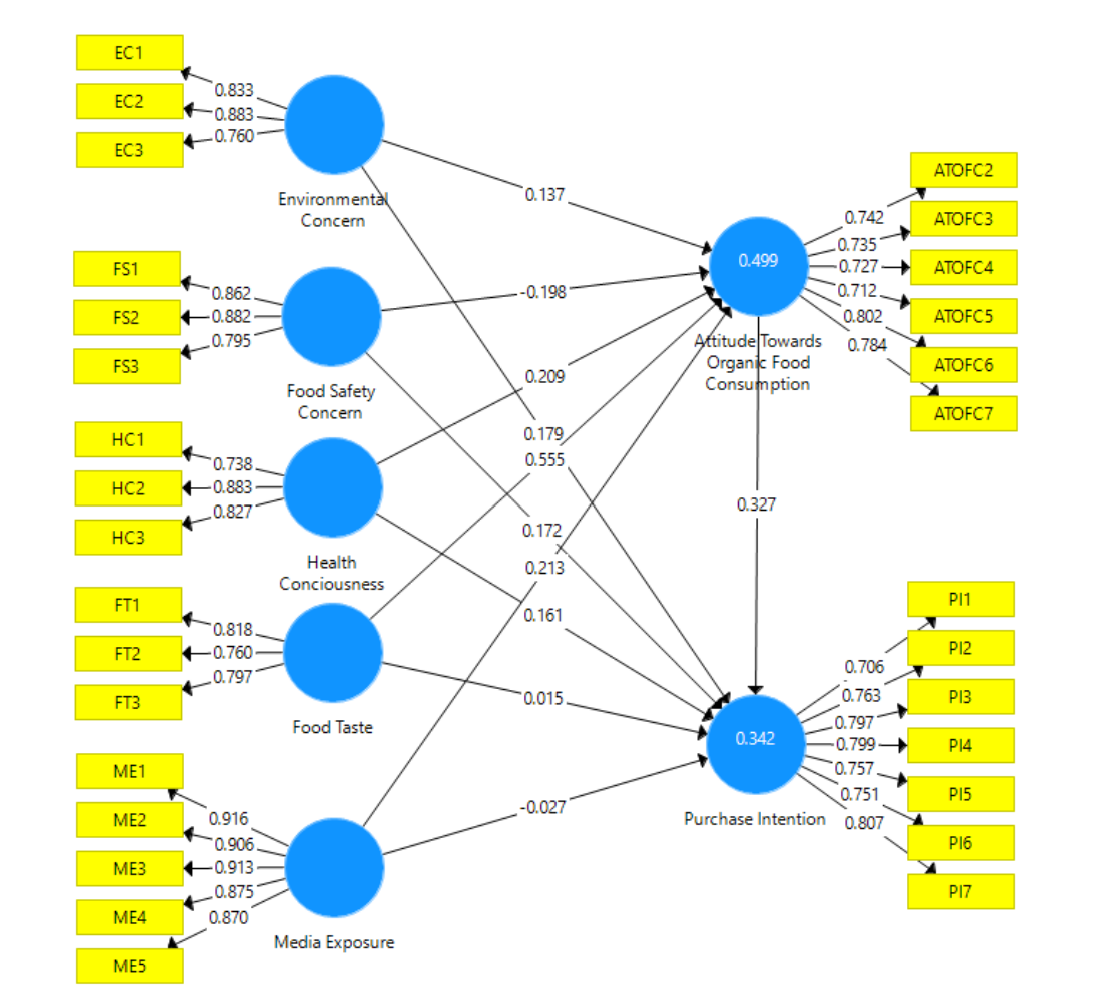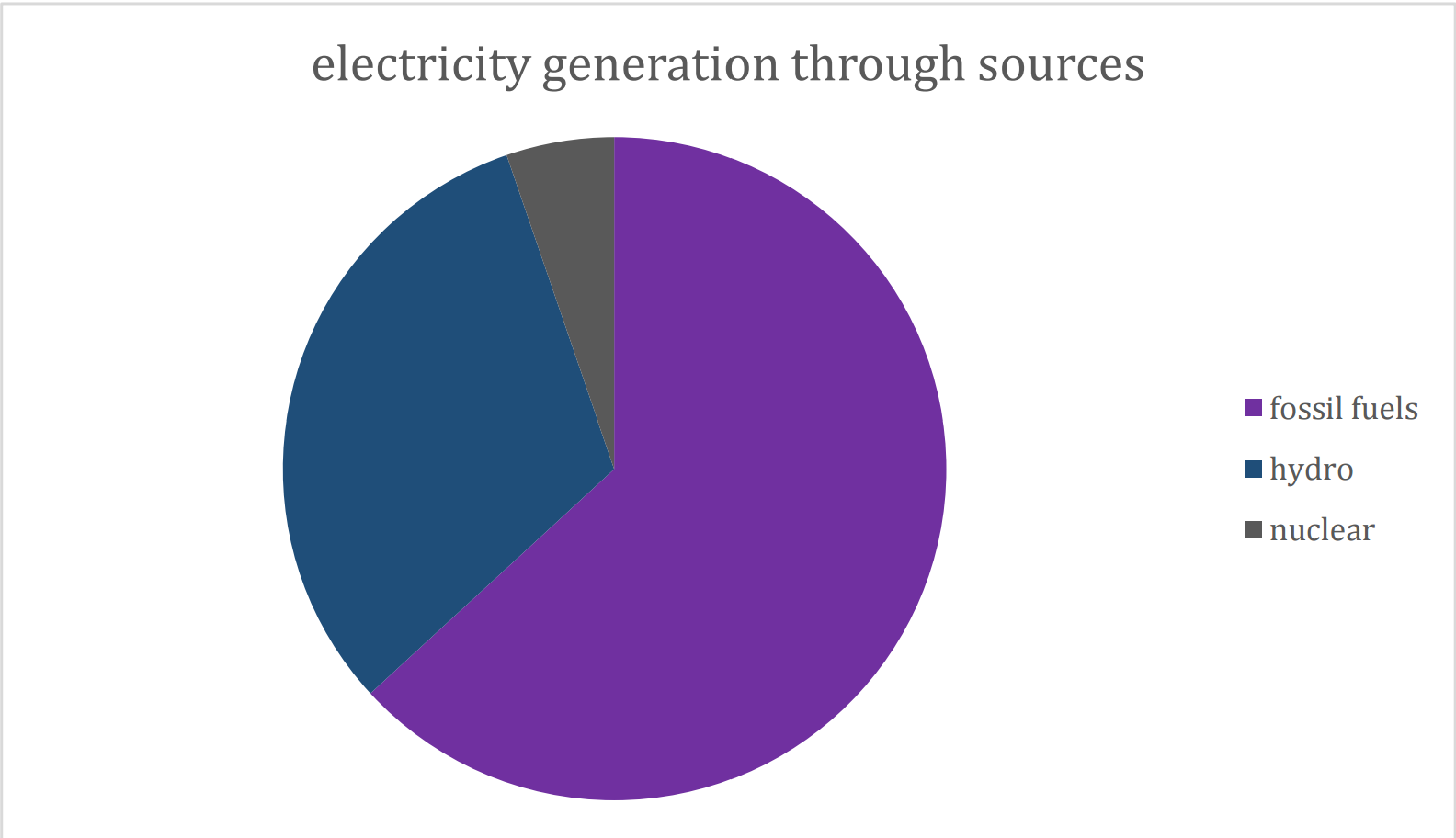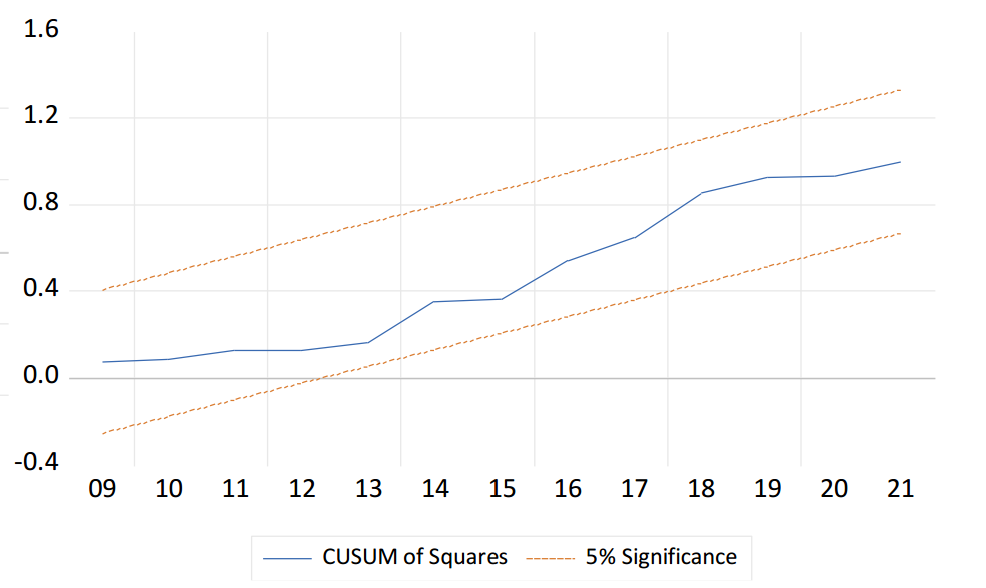ARDL and VECM Investigation of the Environmental Kuznets Curve Hypothesis in Egypt, India, Mexico, Pakistan, Thailand, and Turkey: Financial Development, Globalization, and Government Expenditure Implications for Sustainable Development
Abstract
The present paper empirically examines the validity of the environmental Kuznets curve (EKC) hypothesis, which posits an inverted U-shaped relationship between CO2 emissions and economic growth, in Egypt, India, Mexico, Pakistan, Thailand, and Turkey for the period 1970-2020. The EKC validity is highly debated due to varying results across countries. This study is significant to addresses this controversy by estimating the EKC's robustness while considering the influence of financial development, globalization, and government expenditure. We employ two cointegration techniques, the autoregressive distributed lag (ARDL) and vector error correction model (VECM), also considering potential structural breaks in the data. Out key findings indicate that the EKC hypothesis is supported in India, Pakistan, and Turkey, with carbon emissions eventually declining after reaching a peak. The hypothesis is not supported in Egypt and Thailand, where emissions rise monotonically with economic growth. In Mexico, the results are mixed, with ARDL suggesting a U-shaped relationship and VECM supporting the EKC. From our empirical analysis of the EKC hypothesis, we derive the following policy implications: 1) countries should adopt comprehensive policy strategies that integrate these goals and fully consider the long-term environmental and societal impacts of their decisions; 2) countries should invest heavily in research and development to accelerate the creation of new technologies that can effectively reduce carbon emissions; and 3) countries must actively raise awareness about the environmental repercussions of economic growth.
Cite This Paper
Fukuda, T. (2024). ARDL and VECM Investigation of the Environmental Kuznets Curve Hypothesis in Egypt, India, Mexico, Pakistan, Thailand, and Turkey: Financial Development, Globalization, and Government Expenditure Implications for Sustainable Development. Energy Technologies and Environment, 2(2), 13. doi:10.58567/ete02020003
Fukuda, T. ARDL and VECM Investigation of the Environmental Kuznets Curve Hypothesis in Egypt, India, Mexico, Pakistan, Thailand, and Turkey: Financial Development, Globalization, and Government Expenditure Implications for Sustainable Development. Energy Technologies and Environment, 2024, 2, 13. doi:10.58567/ete02020003
Fukuda T. ARDL and VECM Investigation of the Environmental Kuznets Curve Hypothesis in Egypt, India, Mexico, Pakistan, Thailand, and Turkey: Financial Development, Globalization, and Government Expenditure Implications for Sustainable Development. Energy Technologies and Environment; 2024, 2(2):13. doi:10.58567/ete02020003
Fukuda, Takashi 2024. "ARDL and VECM Investigation of the Environmental Kuznets Curve Hypothesis in Egypt, India, Mexico, Pakistan, Thailand, and Turkey: Financial Development, Globalization, and Government Expenditure Implications for Sustainable Development" Energy Technologies and Environment 2, no.2:13. doi:10.58567/ete02020003
Share and Cite
Article Metrics
References
- Adebayo, T. S., Kartal, M. T., Ağa, M., & Al-Faryan, M. A. S. (2023). Role of country risks and renewable energy consumption on environmental quality: Evidence from MINT countries. Journal of Environmental Management, 327(1 February), 116884. https://doi.org/10.1016/j.jenvman.2022.116884
- Alola, A. A. & Donve, U. T. (2021). Environmental implication of coal and oil energy utilization in Turkey: is the EKC hypothesis related to energy? Management of Environmental Quality, 32(3), 543-559. https://doi.org/10.1108/MEQ-10-2020-0220
- Arif, M., Chenghu, Z., Olah, J., Shehzad, K., & Ahmad, M. (2022). Specifying the domineering role of governance in the long term environmental excellence: a case study of Pakistan. SAGE Open, 12(3). https://doi.org/10.1177/21582440221121731
- Bernauer, T., Böhmelt, T., & Koubi, V. (2013). Is there a democracy–civil society paradox in global environmental governance? Global Environmental Politics,13(1), 88- 107. https://doi.org/10.1162/GLEP_a_00155
- Bese, E. & Salih, K. (2019). Testing the environmental Kuznets curve hypothesis: evidence from Egypt, Kenya and Turkey. International Journal of Energy Economics and Policy 9(6), S. 479 - 491. https://doi.org/10.32479/ijeep.8638
- Charemza, W. W., & Deadman, D. F. (1997). New directions in econometric practice (2nd ed.). Edward Elgar Publishing.
- Copeland, B. R., & Taylor, M. S. (1994). North-South trade and the environment. Quarterly Journal of Economics, 109(3), 755–787. https://doi.org/10.2307/2118421
- Copeland, B. R., & Taylor, M. S. (2003). Trade, growth and the environment [NBER Working Paper No. 9823]. National Bureau of Economic Research. https://www.nber.org/papers/w9823
- Destek, M. A., & Okumus, I. (2019). Does pollution haven hypothesis hold in newly industrialized countries?: Evidence from ecological footprint. Environmental Science and Pollution Research, 26(23), 23689–23695. https://doi.org/10.1007/s11356-019-05614-z
- El-Aasar1, K. M. & Hanafy, S. H. (2019). Investigating the environmental Kuznets curve hypothesis in Egypt: the role of renewable energy and trade in mitigating GHGs. International Journal of Energy Economics and Policy, 8(3), 177-184. Retrieved from https://www.econjournals.com/index.php/ijeep/article/view/6316
- Elliott, G., Rothenberg, T. J. & Stock, J. H. (1996). Efficient test for an autoregressive unit root. Econometrica, 64(4), 813-836. https://doi.org/10.2307/2171846
- Enders, W. (2014). Applied Econometric Time Series (4th ed.). Wiley.
- Esty, D. C. & Porter, M. E. (1998). Industrial ecology and competitiveness: strategic implications for the firm. Journal of Industrial Ecology, 2(1), 35-43. https://doi.org/10.1162/jiec.1998.2.1.35
- Fukuda, T. (2020). Mexico’s Finance-growth nexus with trade openness, FDI and portfolio investment: evidence from VECM cointegration analysis. Ecos De Economía, 23(49), 29–44. https://doi.org/10.17230/ecos.2019.49.2
- Fukuda, T. (2023). Empirical assessment of the environmental Kuznets curve hypothesis in Indonesia, Malaysia, the Philippines, and Thailand using the ARDL and FMOLS techniques. Energy Economics Letters, 10(1), 19-34. https://doi.org/10.55493/5049.v10i1.4712
- Genç, M. C., Ekinci, A., & Sakarya, B. (2022). The impact of output volatility on CO2 emissions in Turkey: testing EKC hypothesis with Fourier stationarity test. Environmental Science and Pollution Research, 29(2), 3008–3021. https://doi.org/10.1007/s11356-021-15448-3
- Greene, W. H. (2011). Econometric Analysis (7th ed.). Pearson Education.
- Grossman, G. M., & Krueger, A. B. (1991). Environmental impacts of a North American Free Trade Agreement [NBER Working Paper No. 3914]. National Bureau of Economic Research. https://www.nber.org/papers/w3914
- Gygli, S., Haelg, F., Potrafke, N., & Sturm, J. (2019). The KOF Globalisation Index – Revisited. Review of International Organizations, 14(3), 543–574. https://doi.org/10.1007/s11558-019-09344-2
- Hashmi, S. H., Fan, H., Fareed, Z., & Bannya, R. (2020). Testing non-linear nexus between service sector and CO2 emissions in Pakistan. Energies,13(3), 526. https://doi.org/10.3390/en13030526
- Hussain, H. I., Haseeb, M., & Kamarudin, H., Dacko-Pikiewicz, Z., & Szczepańska-Woszczyna, K. (2021). The role of globalization, economic growth and natural resources on the ecological footprint in Thailand: evidence from nonlinear causal estimations. Process, 9(7), 1103. https://doi.org/10.3390/pr9071103
- Johansen, S. (1988). Statistical analysis of cointegration vectors. Journal of Economic Dynamics and Control, 12(2-3), 231-254. https://doi.org/10.1016/0165-1889(88)90041-3
- Johansen, S., Juselius, K. (1992). Testing structural hypotheses in a multivariate cointegration analysis of the PPP and the UIP for UK. Journal of Econometrics, 53(1-3), 211-244. https://doi.org/10.1016/0304-4076(92)90086-7
- Johansen, S., Mosconi, R., & Nielsen, B. (2000). Cointegration analysis in the presence of structural breaks in the deterministic trend. Econometrics Journal, 3(2), 216-249. https://doi.org/10.1111/1368-423x.00047
- Khan, A., Safdar, S., & Nadeem, H. (2023). Decomposing the effect of trade on environment: a case study of Pakistan. Environmental Science and Pollution Research, 30(2), 3817–3834. https://doi.org/10.1007/s11356-022-21705-w
- Kilavuz, E. & Dogan, I. (2021). Economic growth, openness, industry and CO2 modelling: are regulatory policies important in Turkish economies? International Journal of Low-Carbon Technologies, 16(2), 476-487. https://doi.org/10.1093/ijlct/ctaa070
- Kim, H. S., & Baek, J. (2011). The environmental consequences of economic growth revisited. Economics Bulletin, 31(2), 1198-1211.
- KOF Swiss Economic Institute. (2023, December 24). KOF Globalisation Index. https://www.kof.ethz.ch/en/forecasts-and-indicators/indicators/kof-globalisation-index.html
- Le, H. P., & Ozturk, I. (2020). The impacts of globalization, financial development, government expenditures, and institutional quality on CO2 emissions in the presence of environmental Kuznets curve. Environmental Science and Pollution Research, 27(18), 22680–22697. https://doi.org/10.1007/s11356-020-08812-2
- Leal, P. H. & Marques, A. C. (2022). The evolution of the environmental Kuznets curve hypothesis assessment: a literature review under a critical analysis perspective. Heliyon, 8(11), E11521.
- Lee, J., & Strazicich, M. S. (2003). Minimum LM unit root test with two structural breaks. Review of Economics and Statistics, 85(4), 1082-1089. https://doi.org/10.1162/003465303772815961
- Lee, J., & Strazicich, M. S. (2004). Minimum LM unit root test with one structural break. Appalachian State University Working Paper. Boone: Appalachian State University. Retrieved from https://econ.appstate.edu/RePEc/pdf/wp0417.pdf
- Mahmood, H., Furqan, M., Alkhateeb, T. T. Y., & Fawaz, M. M. (2019). Testing the environmental Kuznets curve in Egypt: role of foreign investment and trade. International Journal of Energy Economics and Policy, 9(2), 225-228. https://doi.org/10.32479/ijeep.7271
- Miranda, R. A., Hausler, R., Lopez, R. R., Glaus, M., & Pasillas-Diaz, J. R. (2020). Testing the environmental Kuznets curve hypothesis in North America’s Free Trade Agreement (NAFTA) countries. Energies, 13(12), 3104. https://doi.org/10.3390/en13123104
- Mohammed, A. M. S., Guo. P., Haq, I., Pan, G., & Khan, A. (2019). Do government expenditure and financial development impede environmental degradation in Venezuela? Plos One, 14(1), e0210255. https://doi.org/10.1371/journal.pone.0210255
- Nordhaus, W. D. (2008). A question of balance: weighing the options on global warming policies. Yale University Press.
- Our World in Data. (2023, December 24). Per capita CO₂ emissions. Our World in Data. https://ourworldindata.org/explorers/co2
- Paweenawat, S. W. & Plyngam, S. (2017). Does the causal relationship between renewable energy consumption, CO2 emissions, and economic growth exist in Thailand?: an ARDL approach. Economics Bulletin, 37(2), 697-711.
- Pesaran, M. H., Shin, Y., & Smith, R. J. (2001). Bounds testing approaches to the analysis of level relationships. Journal of Applied Econometrics, 16(3), 289-326. https://doi.org/10.1002/jae.616
- Phillips, P. C. B., & Perron, P. (1988). Testing for a unit root in time series regression. Biometrika, 75(2), 335–346. https://doi.org/10.1093/biomet/75.2.335
- Rafindadi, A. A., and Usman, O. (2019). Globalization, energy use, and environmental degradation in South Africa: startling empirical evidence from the Maki-cointegration test. Journal of Environmental Management, 244(August 2019), 265-275. https://doi.org/10.1016/j.jenvman.2019.05.048
- Rana, R. & Sharma, M. (2019). Dynamic causality testing for EKC hypothesis, pollution haven hypothesis and international trade in India. Journal of International Trade and Economic Development, 28(3), 348-364. https://doi.org/10.1080/09638199.2018.1542451
- Rayhan, I., Al Nahian, M. A., & Siddika, A. (2020). Re-evaluating the environmental Kuznets curve and environmental Phillips curve in Bangladesh: an augmented ARDL bounds test approach with a structural break. Jahangirnagar Economic Review, 31, 109–134. https://www.researchgate.net/publication/366557814
- Ridzuan, R. A., Albani, A., Latiff, A. R. A., Razak, M. I. M., & Murshidi, M. H. (2020). The impact of energy consumption based on fossil fuel and hydroelectricity generation towards pollution in Malaysia, Indonesia and Thailand. International Journal of Energy Economics and Policy, 10(1), 215-227. https://doi.org/10.32479/ijeep.8140
- Sadorsky, P. (2013). Financial development and energy consumption in Central and Eastern European frontier economies. Energy Policy, 39(2), 999-1006. https://doi.org/10.1016/j.enpol.2010.11.034
- Seri C, & Fernandez, A. D. J. (2021). The relationship between economic growth and environment: testing the EKC hypothesis for Latin American countries. https://doi.org/10.48550/arXiv.2105.11405
- Stern, D. I. (2004). The rise and fall of the environmental Kuznets curve. World Development, 32(8), 1419-1439. https://doi.org/10.1016/j.worlddev.2004.03.004
- Sultan1, Z. A., Alkhateeb, T. T. Y., & Adow, A. H. (2021). Verifying the environmental Kuznets curve hypothesis in the case of India. International Journal of Energy Economics and Policy, 11(2), 127-132. https://doi.org/10.32479/ijeep.10392
- Toda, H. Y. & Phillips, P. C. B. (1993). Vector autoregression and causality. Econometrica, 61(6), 1367–1393.
- United Nations. (2015). Paris agreement. United Nations Climate Change. https://unfccc.int/sites/default/files/english_paris_agreement.pdf
- United Nations. (2023, December 24). Sustainable development. United Nations, Department of Economic and Social Affairs. https://sdgs.un.org/
- United Nations. (2024, March 3). UN Climate Change Conference - United Arab Emirates. United Natons Climate Change. https://unfccc.int/cop28
- Villanthenkodath, M. A., Gupta, M., Saini, S., & Sahoo, M. (2021). Impact of economic structure on the environmental Kuznets curve (EKC) hypothesis in India. Journal of Economic Structures, 10(28). https://doi.org/10.1186/s40008-021-00259-z
- Ward, H., Cao. X., & Mukherjee, B. (2014). State capacity and the environmental investment gap in authoritarian states. Comparative Political Studies, 47(3), 309–343. https://doi.org/10.1177/0010414013509569
- World Bank. (2023, December 24). World Development Indicators. DataBank. https://databank.worldbank.org/source/world-development-indicators
- Zafar, M. W., Zaidi, S. A. H., Mansoor, S., Sinha, A., & Qin, Q. (2022). ICT and education as determinants of environmental quality: the role of financial development in selected Asian countries. Technological Forecasting and Social Change, 177(April 2022), 121547. https://doi.org/10.1016/j.techfore.2022.121547
- Zivot, E., & Andrews, D. W. K. (1992). Further evidence on the great crash, the oil-price shock, and the unit-root hypothesis. Journal of Business and Economic Statistics, 10(3), 251-270. https://doi.org/10.2307/1391541



